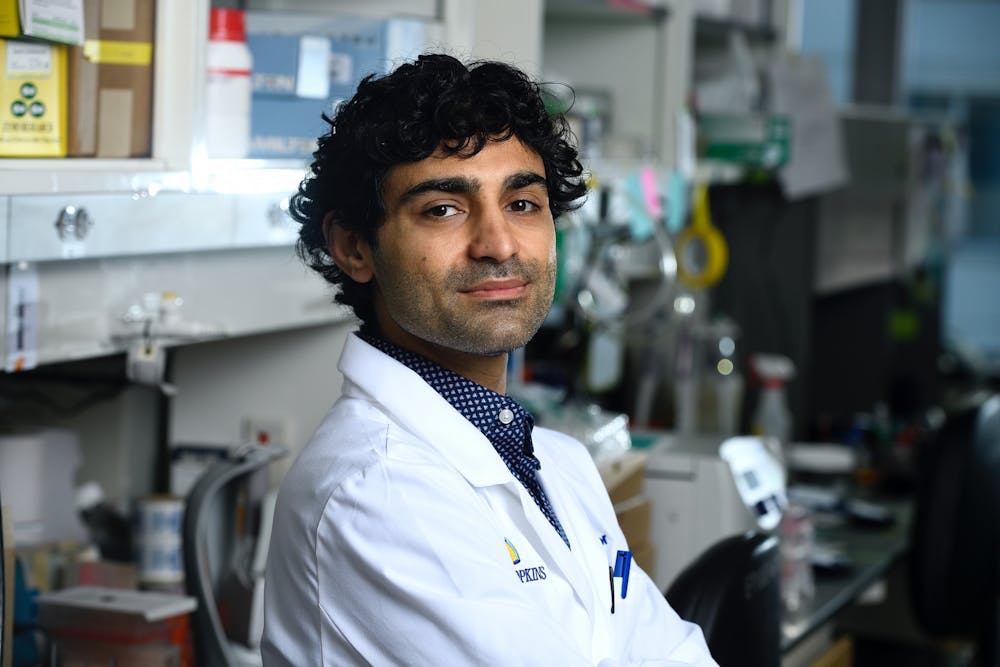While movies like Jurassic World and Gattaca make the idea of editing genes seem wild and dangerous, some researchers at Hopkins have put these movie-induced fears to rest with applications for genetic engineering (which are far less likely to create dinosaurs that even Chris Pratt can’t tame). One of these scientists is Reza Kalhor, an assistant professor in the Department of Biomedical Engineering.
In his research, Kalhor used gene editing technology to insert snippets of genetic elements into the mouse genome. But instead of these snippets affecting the resulting phenotype — the observable characteristics resulting from genes — the snippets had the ability to record information about the cell experience. As the cell divides during embryogenesis and the zygote (the fertilized egg) becomes a developed organism, the genetic snippets in billions of the resulting cells can give us information about the events that occurred during the embryogenesis.
“We hope that in the future, this type of strategy will help us better understand the very complex process of embryogenesis and identify the roots of congenital diseases that are rooted in the most formative stages of one’s life,” Kalhor wrote in an email to The News-Letter.
For his newly developed technique using genetic engineering to record the events of embryogenesis, Kalhor was awarded the Packard Fellowship.
The Packard Fellowships for Science and Engineering are prestigious fellowships awarded by the David and Lucile Packard Foundation. The fellowship funds research that philanthropists David and Lucile Packard supported in their lifetime, including climate science, reproductive health, agriculture and many others.
Kalhor is one of 20 recipients of this fellowship in 2020. He will receive $875,000 over a period of five years to continue funding this research.
Kalhor received his PhD in Molecular and Computational Biology from the University of Southern California in 2012 and completed his postdoctoral fellowship at Harvard Medical School in 2019; he then joined the Hopkins faculty in the Department of Engineering and Center for Epigenetics in 2019. He is the 15th scientist or engineer affiliated with Hopkins to receive the Packard Fellowship.
Kalhor explained that being the recipient of this fellowship will help him and his lab to further pursue research in this field that they may not be able to otherwise.
“For example, one idea that I find interesting is to expand the scope of information we record about developmental events. This will be important in making more comprehensive the story we tell about development,” he wrote.
Much of the research in the Kalhor lab is devoted to developing technologies to understand development and abnormalities in development.
According to Kalhor, the lab is inspired by the complexity of the developmental process during and after embryogenesis. Some approaches frequently used in the lab include molecular biology, genomics, molecular engineering, computational biology and synthetic biology, which he is particularly interested in.
“I like to think that I am drawn by the problem; it so happens that some of the solutions we have envisioned are synthetic biological,” Kalhor wrote.
Since many of the researchers in Kalhor’s lab are newly minted PhD students in their training phase, adapting research in the lab to fit COVID-19 social distancing guidelines has been a challenge. As a result, Kalhor has shifted much recent lab activity toward computational research over the past several months.
While there have been challenges due to COVID-19, the lab’s goal of finding creative solutions remains unchanged.
“I find it interesting when we can envision creative and effective solutions to problems we care about and work in a systematic way to implement them,” he wrote.
Another field of research that the lab has taken on developing methods for in situ (direct from the cell) readouts of both DNA and RNA. This can really be a helpful tool for genetic detection and the investigation of specific cellular phenotypes inside the body.
In addition, the lab has looked into developing molecular devices for in vivo barcoding of DNA with high efficacy and fewer negative side effects. These barcodes could hopefully help to record lineage history in an organism and even dissect some of the genetic cancer biology in organisms.
Therefore, while Kalhor’s research may not allow genetically engineered dinosaurs to roam the Hopkins campus anytime soon, his research will most definitely have an impact on learning about embryonic development and help to further push boundaries in the field of synthetic biology.





